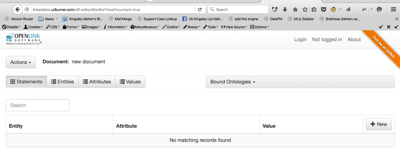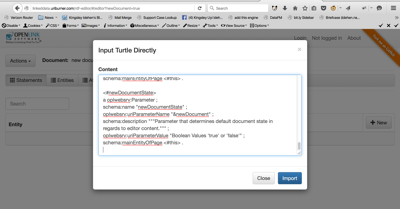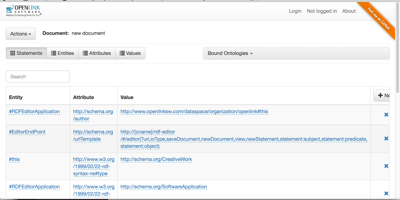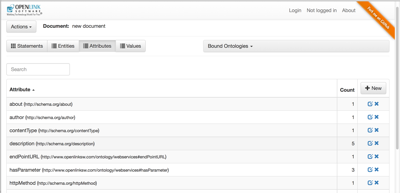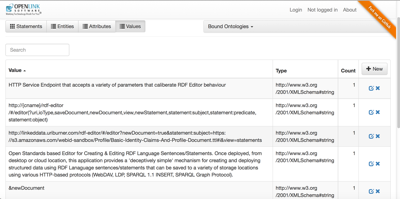![]()
OSDE
The OpenLink Structured Data Editor
What is OSDE?
OSDE, the OpenLink Structured Data Editor, is a tool for creating and editing structured data using RDF Language statements/triples, through many web browsers.
OSDE enables creation and editing of data using abstract subject → predicate → object or entity → attribute → value notation.
OSDE currently ingests RDF from documents serialized as RDF-Turtle, JSON-LD, and RDF/XML.
Once constructed or edited, data can be saved to local or remote storage, or directly copied, as RDF-Turtle documents.
Full RDF-Turtle document access requires that HTTP-accessible host servers support at least one of the following open standards —
Data stored as RDF-Turtle documents can be further transformed to other formats (JSON-LD, CSV, OData, Microdata, RDF/XML, RDF/JSON, etc.) using a variety of transformation tools and services.
Note: Safari 9.1.2 and earlier have an issue with memory consumption; this is resolved by updating to Safari Technology Preview, Release 10, of 2016-08-03 (requires OS X 10.11.4 or later).
Why is OSDE Important?
The World Wide Web (or simply, the Web) was originally conceived as a Read-and-Write medium, but even now, with user-created content filling many web surfers' screens, most usage remains Read-Only.
OSDE bolsters the growing Write dimension by letting users create structured data using the familiar File Create → Save → Share pattern, without forcing a document storage location, i.e., documents created with OSDE may be stored to the desktop or to virtually anywhere in the cloud.
Features of OSDE
- There is no assumption that Structured Data will be created in English; i.e., structured data
can be annotated with language tags identifying the natural language of each annotation.
(For example, if annotating in English, you would put “
en” in thelangfield, when prompted.) - Shared Ontologies/Vocabularies may be imported to ease data entry.
- Sentence predicate types are intelligently suggested, driven by Ontology/Vocabulary lookups.
- Automatic profile lookup — if authenticated via WebID+TLS protocol — provides default document storage locations and (eventually) other preferences.
- A variety of EDIT views are scoped to Statements, Entities, Attribute Names, and Attribute Values. Users can switch between these views to suit their own editing modality preferences.
- Documents may be saved (or downloaded) to local or cloud storage.
- Cloud Storage supports multiple HTTP-based storage protocols (WebDAV, LDP, SPARQL Graph Protocol, SPARQL 1.1 Update).
- Deployment may be through Apache, IIS, Node.js, Tomcat, OpenLink Virtuoso, or any other HTTP Server.
- OSDE is 100% Javascript.
- OSDE is made available as Open Source (via GitHub). Note — For a number of reasons, the GitHub branches may lag behind our internal branches, from which we produce the downloads linked below, which are used to power our Live demo instance.
How do I use OSDE?
Overview
Metaphorically, as in the real-word —
- You write sentences to a document (e.g., a page in a book).
- Sentences in a page are grouped by paragraphs. OSDE groups statements by attribute (predicate) to emulate this concept.
- A document may be part of a collection — like one of many pieces of paper in a folder, pages in a chapter, or chapters in a book. When writing to a SPARQL server, OSDE treats each document as a named graph.
Somewhat more elaborately —
- You write "entity → attribute → value" statements or "subject → predicate → object" triples to a document, which is identified by an HTTP-scheme URL.
- Entity and Attribute (or, if you prefer RDF parlance, Subject and Predicate) are each identified by an HTTP URI, which may be absolute or relative to the document. Value (a/k/a Object) may be either a literal string or a URI.
- Sentence/Statement collections are grouped by Attribute (Predicate), and this is the basis for optimistic concurrency hashes constructed for handling multi-user editing activity against the same document.
You can get started by creating a brand new document or applying edits to an existing document.
Using an existing OSDE Instance, Local or Hosted
Basic Usage
- Set a location for your document. This could be a folder to contain a new document, or the target document itself.
- Open your document from its location.
- Add or edit RDF Language statements using any of the view options — defaults are Statements, Entities, Attributes, Values. Configuration options let you change these labels to Triples, Subjects, Predicates, Objects.
- Save your document to your desktop (via download link) or to a remote cloud location that supports one of:
- Done.
Demonstration of Turtle Input
Start OSDE with a New Document.
From the Action menu, select Input Turtle Directly. Paste or type your Turtle, and click Import.
Inspect and/or edit the imported data in Statements view.
Inspect and/or edit the imported data in Entities (Subjects) view.
Inspect and/or edit the imported data in Attributes (Predicates) view.
Inspect and/or edit the imported data in Values (Objects) view.
Usage Screencasts
Here are a couple of silent screencasts showing OSDE in action, through loose coupling to the OpenLink Structured Data Sniffer (OSDS), which exposes OSDE as its Annotation feature.
OpenLink RDF Editor Demo -- Open Data Flow
OSDS & OSDE Integration Demo — Beyond Bookmarking Annotation Feature
Deploying a new OSDE instance
If you don't have an existing OSDE instance, deployment takes just a few simple steps, which vary with your HTTP server.
- For deployment on Virtuoso Enterprise Edition 7.2+, there are version-specific
VAD packages
(
rdf_editor_dav.vad). - For deployment on any other HTTP server, including Virtuoso Open Source Edition or Virtuoso Enterprise Edition ≤7.1, there is a
ZIP archive
(
rdf_editor_pkg.zip).
Apache
- Download and install Apache (v2.x).
- Extract RDF Editor:
unzip rdf_editor_pkg.zip -d [PATH] - Add new drectory (
/rdf-edtor) with RDF Editor to the server configuration. - Start Apache Server.
[APACHE HOME]/bin/httpd - Load this URI in your web browser:
http://localhost:[port]/rdf-editor/index.html
IIS
- Start IIS.
- Extract RDF Editor:
unzip rdf_editor_pkg.zip -d [IIS Root Path] - Load this URI in your web browser:
http://localhost:[port]/rdf-editor/index.html
Node.js
- Download and install Node.js.
- Download and install NPM manager.
- Install the
node.js http-server(a simple, zero-configuration command-line http server) globally, so that it may be run from the command line:npm install http-server -g - Extract RDF Editor:
unzip rdf_editor_pkg.zip -d [RDF Editor Path] - Start the HTTP Server:
http-server [RDF Editor Path]/rdf-editor [options] - Load this URI in your web browser:
http://localhost:[port]/index.html
Tomcat
- Download and install Tomcat (v8.x).
- Start Tomcat.
[TOMCAT HOME]/bin/startup - Extract RDF Editor:
unzip rdf_editor_pkg.zip -d [TOMCAT HOME]/webapps/Root - Load this URI in your web browser:
http://localhost:[port]/rdf-editor/index.html
Virtuoso Enterprise Edition 7.2+
- In the Virtuoso Conductor, navigate to the System Admin → Packages tab,
and use the Install Packages section to install the OSDE VAD package, called
rdf_editor_dav.vad.- If not yet listed, download the
rdf_editor_dav.vadpackage for your version of Virtuoso from our repository.
- If not yet listed, download the
- OSDE will be available at a URL similar to that below, where
cnameis the{hostname}:{port-number}at which your Virtuoso instance is listening.http://{cname}/rdf-editor/index.html
Virtuoso Open Source Edition or Enterprise Edition ≤7.1
- Mount your Virtuoso DAV repository to your local filesystem.
- Unzip the RDF Editor ZIP archive to your preferred location in the DAV tree.
- If desired, use the Virtuoso Conductor to configure a vdir
to listen at, for instance,
http://{cname}/rdf-editor/index.html, and expose the physical location you chose for the extraction.
Custom Crafting OSDE-Controlling URIs
You can use an XHR-oriented parameterized URL to load the Editor with a number of UI choices already made. Several examples follow the parameter details, all based on the URI Template —
http://{cname}/rdf-editor/#/editor(?uri,ioType,saveDocument,newDocument,view,newStatement,statement:subject,
statement:predicate,statement:object)
URL Parameters
Usable with READ-oriented GET and POST Methods
newDocument— Drops current OSDE content before next action. Optional values:trueorfalse.uri— URL encoded URI of the resource to be opened by OSDE.view— The editor view is identified by one of the following values:statementsortriples— The default view. Always valid.entitiesorsubjects— The default view whenstatement:subjectis set. Invalid whenstatement:predicateorstatement:objectis set.attributesorpredicates— The default view whenstatement:predicateis set. Invalid whenstatement:subjectorstatement:objectis set.valuesorobjects— The default view whenstatement:objectis set. Invalid whenstatement:subjectorstatement:predicateis set.
newStatement— The editor will be opened in 'new statement' state.statement:subject— URL encoded URI value to be initially used as the subject of new statements. If the view parameter is omitted, the editor is opened in Subjects view. When this parameter is used, the enabled values for the view parameter arestatementsandsubjects.statement:predicate— URL encoded URI value to be initially used as the predicate of new statements. If the view parameter is omitted, the editor is opened in Predicates view. When this parameter is used, the enabled values for the view parameter arestatementsandpredicates.statement:object— URL encoded URI value to be initially used as the object of new statements. If the view parameter is omitted, the editor is opened in Objects view. When this parameter is used, the enabled values for the view parameter arestatementsandobjects.
Usable with WRITE-oriented POST Methods
uri— URL encoded URI of the resource to be written by OSDE.ioType— Protocol to use to access the target resource. Optional values:webdav— The document will be accessed using WebDAV protocolldp— The document will be accessed using LDP protocolsparql— The document will be accessed using SPARQL protocolhttp— The document will be accessed using HTTP protocol
sparqlEndpoint— URL encoded URI that identifies SPARQL endpoint to be used when source document content is identified by a SPARQLCONSTRUCTorDESCRIBEquery results URLsaveDocument— Save current content to document identified by the Document URI. Optional values:trueorfalse
Custom URI Examples
[1] Open 'New Document' using 'Statements' view with specific 'Entity' for new Statement
Place Editor in 'New Document' state with current Entity identified by
<http://dbpedia.org/resource/DBpedia>
as the Entity of the initial EAV Statement, using 'Statements' view —
[2] Open 'New Document' using 'Entities' view with specific 'Entity' for new Statement
Place Editor in 'New Document' state with current Entity identified by
<http://dbpedia.org/resource/DBpedia>
as the Entity of the initial EAV Statement, using 'Entities' view —
[3] Open 'New Document' using 'Attributes' view with specific 'Attribute' for new Statement
Place Editor in 'New Document' state with current Entity identified by
<http://www.w3.org/1999/02/22-rdf-syntax-ns#type>
as the Attribute of the initial EAV Statement, using 'Attributes' view —
[4] Open 'New Document' using 'Values' view with specific 'Value' for new Statement
Place Editor in 'New Document' state with current Value identified by
"Initial Value"
as the Value of the initial EAV Statement, using 'Values' view —
[5] Open existing document using default (i.e., 'Statements') view
Opens up the Description of <https://dbpedia.org/resource/DBpedia>
in the Editor, using the default EAV 'Statements' view —
[6] Open existing document forcing 'Statements' (default) view
Opens up the Description of <https://dbpedia.org/resource/DBpedia>
in the Editor, using the default EAV 'Statements' view —
[7] Open existing document using default 'Statements' view
Opens up <https://dbpedia.org/ontology/Company>
in the Editor, using the default Statements view —
http://linkeddata.uriburner.com/rdf-editor/#/editor?uri=http:%2F%2Fdbpedia.org%2Fontology%2FCompany
[8] Open existing document in 'Statements' view with specific 'Entity' for new Statement
Opens up <https://s3.amazonaws.com/webid-sandbox/Profile/Basic-Identity-Claims-And-Profile-Document.ttl>
in the Editor, using Statements view, with
<http://dbpedia.org/resource/DBpedia>
set as the Entity of an additional Statement —
Troubleshooting
CORS Error: {document} failed to load - this could be related to missing CORS settings on the server.
This somewhat cryptic error message results from a complex set of web browser and web server behaviors and design choices. If you encounter a message like this, please see our detailed discussion of Cross-Origin Resource Sharing (CORS) Errors.


